This unusually sophisticated critical analysis assesses a portion of the immensity required to produce and run our Electric Civilization era. The following exposition contains inline segments of the map—linked to full-size map segments—and endnote references within [square braces] in the paragraphs where the endnote numbers appear in the original text. A majority of references link to complete online sources. Additional hyperlink references have been added to facilitate further study of sources cited.
AI Now Institute and Share Lab, 7 Sep 2018
Kate Crawford is a leading researcher and professor who has spent the last decade studying the social implications of data systems, machine learning and artificial intelligence. She is the co-director and co-founder of the AI Now Institute at New York University, the world’s first university institute dedicated to researching the social implications of artificial intelligence and related technologies.
Vladan Joler is SHARE Foundation co-founder and professor at the New Media department of the University of Novi Sad, Serbia. He is leading SHARE Lab, a research and data investigation lab for exploring different technical and social aspects of algorithmic transparency, digital labour exploitation, invisible infrastructures, black boxes, and many other contemporary phenomena on the intersection between technology and society.
With each interaction, Alexa is training to hear better, to interpret more precisely, to trigger actions that map to the user’s commands more accurately, and to build a more complete model of their preferences, habits and desires. What is required to make this possible? Put simply: each small moment of convenience – be it answering a question, turning on a light, or playing a song – requires a vast planetary network, fueled by the extraction of non-renewable materials, labor, and data. The scale of resources required is many magnitudes greater than the energy and labor it would take a human to operate a household appliance or flick a switch. A full accounting for these costs is almost impossible, but it is increasingly important that we grasp the scale and scope if we are to understand and govern the technical infrastructures that thread through our lives.
Our exploded view diagram combines and visualizes three central, extractive processes that are required to run a large-scale artificial intelligence system: material resources, human labor, and data. We consider these three elements across time – represented as a visual description of the birth, life and death of a single Amazon Echo unit. It’s necessary to move beyond a simple analysis of the relationship between an individual human, their data, and any single technology company in order to contend with the truly planetary scale of extraction.
If you read our map from left to right, the story begins and ends with the Earth, and the geological processes of deep time. But read from top to bottom, we see the story as it begins and ends with a human.

